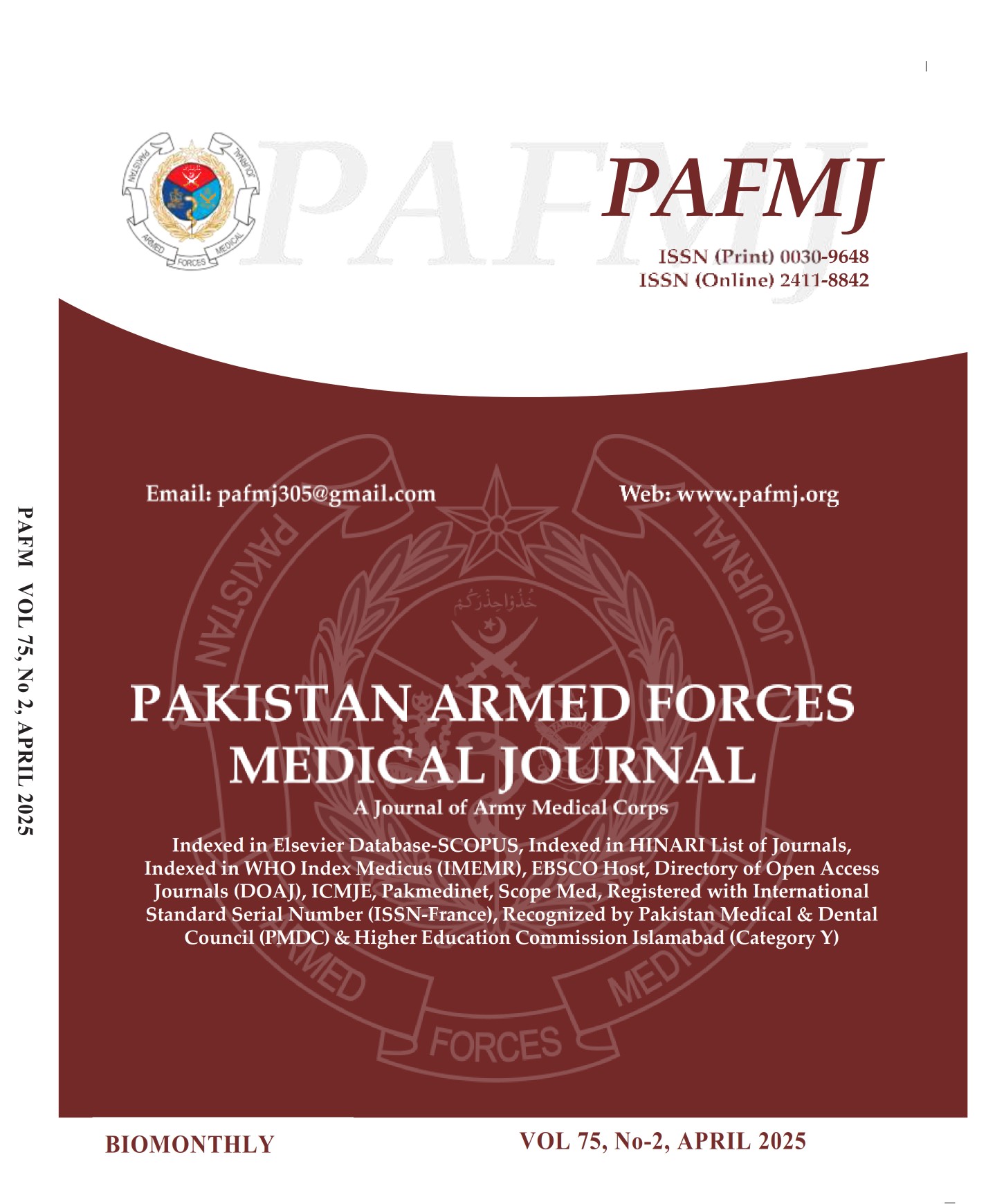Comparison of Online Clearance Monitoring and Daugirdas Formula for The Assessment of Haemodialysis Adequacy
DOI:
https://doi.org/10.51253/pafmj.v75i2.8075Keywords:
End Stage Renal Disease, Haemodialysis, Renal Clearance, Renal Replacement TherapyAbstract
Objective: To determine if urea kinetic modelling (Kt/V) by online clearance monitoring (OCM) could be used as an alternative to Kt/V calculated using Daugirdas equation.
Study Design: Cross-sectional study
Place and Duration of Study: Dialysis Unit, Combined Military Hospital Peshawar, Pakistan, Nov 2019 to Feb 2020.
Methodology: Outdoor patients on maintenance thrice-weekly hemodialysis were selected using non-probability convenience sampling. Body weight was measured and serum urea levels were checked before and after each haemodialysis session. Kt/V- Daugirdas was calculated using Calculate by QxMD android application. Kt/V online clearance monitoring was determined using the built-in online clearance monitoring module of Fresenius F4008 haemodialysis machines.
Results: Amongst 47 patients aged 55.47±13.66 years, 34(72.34%) were males. Patients were assessed during 63 hemodialysis sessions. Kt/V was 1.21±0.24 and 1.44±0.46 by online clearance monitoring and Daugirdas formula respectively (p<0.001). There was a positive correlation between the two (r=0.373, p=0.003). In 24(38.10%) sessions, both Kt/V online clearance monitoring and Kt/V Daugirdas targets of 1.2 (minimum) were achieved. Kt/V Daugirdas target was achieved more frequently than Kt/V online clearance monitoring (66.67% vs 46.03%; p=0.012). Kt/V Daugirdas targets were better attained amongst patients with arteriovenous fistula as compared to those tunneled dialysis catheters (74.00 vs 38.46%; p=0.015). This was not true for Kt/V online clearance monitoring targets (p=0.992).
Conclusion: Online clearance monitoring is non-invasive and can reliably be used to screen for hemodialysis adequacy even though it slightly underestimates Kt/V as compared to the Daugirdas formula.
Downloads
References
Hasan M, Sutradhar I, Gupta RD, Sarker M. Prevalence of chronic kidney disease in South Asia: a systematic review. BMC Nephrol 2018;19(1):291.
https://doi.org/10.1186/s12882-018-1072-5
Imran S, Sheikh A, Saeed Z, Khan SA, Malik AO, Patel J, et al. Burden of chronic kidney disease in an urban city of Pakistan, a cross-sectional study. J Pak Med Assoc 2015;65(4):366-369.
Imtiaz S, Alam A. Is haemodialysis the most feasible dialysis modality for Pakistan? J Pak Med Assoc 2021;71(2A):528-530. https://doi.org/10.47391/JPMA.129
Saeed F, Sardar M, Rasheed K, Naseer R, Epstein RM, Davison SN, et al. Dialysis decision making and preferences for end-of-life care: perspectives of Pakistani patients receiving maintenance dialysis. J Pain Symptom Manage 2020;60(2):336-345.
https://doi.org/10.1016/j.jpainsymman.2020.03.009
Somji SS, Ruggajo P, Moledina S. Adequacy of hemodialysis and its associated factors among patients undergoing chronic hemodialysis in Dar es Salaam, Tanzania. Int J Nephrol 2020;2020:9863065.
https://doi.org/10.1155/2020/9863065
Breitsameter G, Figueiredo AE, Kochhann DS. Calculation of Kt/V in haemodialysis: a comparison between the formulas. J Bras Nefrol 2012; 34(1):22-26.
https://doi.org/10.1590/S0101-28002012000100004
Kohn MA, Senyak J. Sample Size Calculators. University of California San Francisco Clinical and Translational Science Institute (Accessed on 10/10/2019). Available from: https://www.sample-size.net/
Hong WP, Lee YJ. The association of dialysis adequacy, body mass index, and mortality among hemodialysis patients. BMC Nephrol 2019; 20(1):1-8.
https://doi.org/10.1186/s12882-019-1570-0
National Kidney Foundation. KDOQI clinical practice guideline for hemodialysis adequacy: 2015 update. Am J Kidney Dis 2015; 66(5):884-930.
https://doi.org/10.1053/j.ajkd.2015.07.015
Ahrenholz P, Taborsky P, Bohling M, Rawer P, Ibrahim N, Gajdos M, et al. Determination of dialysis dose: a clinical comparison of methods. Blood Purif 2011; 32(4):271-277.
https://doi.org/10.1159/000330340
Fazl-E-Mateen, Ahmad S, Elahi I, Anees M. Comparison between different methods of calculating Kt/V as the marker of adequacy of dialysis. Pak J Med Sci 2022; 38(1):167-171. https://doi.org/10.12669/pjms.38.1.4281
Kim DH, Park JI, Lee JP, Kim YL, Kang SW, Yang CW, et al. The effects of vascular access types on the survival and quality of life and depression in the incident hemodialysis patients. Ren Fail 2020; 42(1):30-39.
https://doi.org/10.1080/0886022X.2019.1702558
Cortez AJ, Paulson WD, Schwab SJ. Vascular access as a determinant of adequacy of dialysis. Semin Nephrol 2005; 25(2):96-101. https://doi.org/10.1016/j.semnephrol.2004.09.016
Zamani P, Mohammadi H, Feyzi H. Comparison of Dialysis Adequacy in Permanent Vascular Access Methods. J Crit Care Nurs 2021; 14(1):1-7.
Mutevelic A, Spanja I, Sultic-Lavic I, Koric A. The impact of vascular access on the adequacy of dialysis and the outcome of the dialysis treatment: one center experience. Mater Sociomed 2015; 27(2):114-117.
https://doi.org/10.5455/msm.2015.27.4-114-117
Noori N, Wald R, Sharma Parpia A, Goldstein MB. Volume estimates in chronic hemodialysis patients by the Watson equation and bioimpedance spectroscopy and the impact on the Kt/Vurea calculation. Can J Kidney Health Dis 2018;5(1):2054358117750156. https://doi.org/10.1177/2054358117750156
Fernández G, Cerrato A, de la Vara L, Galera E, Roldán C, Martínez J. Comparison of bioimpedance spectroscopy and the Watson formula for measuring body volume in patients on peritoneal dialysis. Nefrologia 2016; 36(1):57-62.
https://dx.doi.org/10.1016/j.nefro.2015.11.002
Alayoud A, Montassir D, Hamzi A, Zajjari T, Bahadi A, El Kabbaj D, et al. The Kt/V by ionic dialysance: Interpretation limits. Indian J Nephrol 2012; 22(5):333-339.
Downloads
Published
Issue
Section
License
Copyright (c) 2025 Abdul Rehman Arshad, Maryam Begum

This work is licensed under a Creative Commons Attribution-NonCommercial 4.0 International License.















